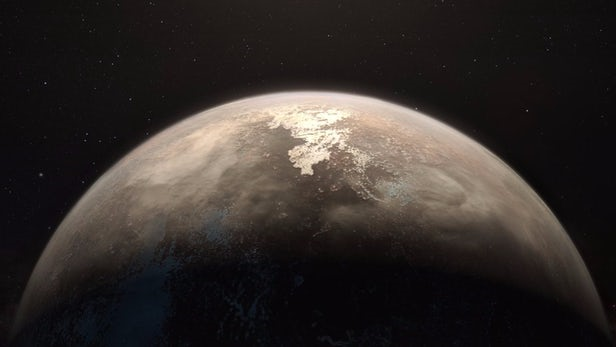 Artist’s impression of Ross 128 b, which was discovered orbiting a red dwarf star – the most common type of stellar body in the universe. (Credit: ESO).
Artist’s impression of Ross 128 b, which was discovered orbiting a red dwarf star – the most common type of stellar body in the universe. (Credit: ESO).
An international team of astronomers has discovered a temperate Earth-sized world with the potential to harbor alien life. The planet, known as Ross 128 b, is located a mere 11 light-years from Earth, and will one day become the closest exoplanet to our Sun, dethroning our current immediate neighbor exoplanet – Proxima b.
Ross 128 b was discovered by researchers using the European Southern Observatory’s (ESO) High Accuracy Radial Velocity Planet Searcher (HARPS) located at the La Silla Observatory in Chile. The HARPS instrument, which is mounted aboard a 3.6-meter optical and near-infrared telescope, does not directly observe exoplanets, but instead watches for a minute wobble in the motion of a host star created by the gravitational influence of an orbiting world.
Astronomers are able to use HARPS data to estimate certain characteristics of an exoplanet, such as its mass, orbital period, and distance from its host star. Exoplanets discovered by HARPS can then be examined in further detail by other instruments and observatories, including the ESO’s Extremely Large Telescope, which is expected to achieve first light in 2024.
“This discovery is based on more than a decade of HARPS intensive monitoring together with state-of-the-art data reduction and analysis techniques,” comments Nicola Astudillo-Defru of the University of Geneva, Switzerland, who co-authored the discovery paper. “Only HARPS has demonstrated such a precision and it remains the best planet hunter of its kind, 15 years after it began operations.”
In this case, HARPS spotted evidence for the existence of the newly discovered exoplanet around the red dwarf star Ross 128. Based on the data, the team estimated that the imaginatively-named exoplanet Ross 128 b orbits its star at the equivalent of one twentieth the distance between the Earth and Sun.
Despite its proximity to its star, Ross 128 b only absorbs about 1.38 times as much radiation as our planet, giving the Earth-sized world a hospitable equilibrium temperature in the range of -60 to 20 °C (-76 to 68 °F). This is because the red dwarf is much smaller and cooler than our star.
Ross 128 is travelling towards our Sun, which means that Ross 128 b will unseat Proxima b to become Earth’s closest exoplanet neighbor in just 79,000 years. The discovery of Proxima b was announced in August 2016 to huge excitement, but there are serious doubts regarding its potential habitability that stems from the nature of its red dwarf parent star, Proxima Centauri.
Whilst red dwarfs are by their nature significantly dimmer and smaller than Sun-like stars, they still have the capacity to emit powerful solar flares that bathe orbiting exoplanets in ultraviolet and X-ray radiation. This onslaught of radiation can strip a nearby world of its atmosphere, essentially causing it to be slowly lost to space. Without this protective shield, an exoplanet would be at the mercy of the radiation pouring from its star.
This is one of the reasons that Proxima b could be inhospitable to the evolution of extraterrestrial life. Ross 128 on the other hand is thought to be relatively inactive, and so may not pose as great a threat to Ross 128 b as Proxima Centauri does to Proxima b.
Ross 128 b has many of the hallmarks that make for a promising target in the search for extraterrestrial life as it shares many similarities to Earth, the only world on which life is known to exist.
There is however a major question mark over the habitability of the exoplanet. The team behind the new discovery is not certain that Ross 128 b orbits within the habitable zone of its star – the region of space in which a planet receives the correct amount of radiation to allow liquid water to exist on its surface.
The presence of liquid water on ancient Earth is considered to be one of the cornerstones of the evolution of life on our planet, and so if Ross 128 b were unable to host liquid water on its surface, it would be damning to the exoplanet’s chances of hosting life.
Astronomers are planning to use cutting-edge, next-generation observatories to search for evidence of biological life in the atmospheres of select Earth-sized, temperate exoplanets orbiting red dwarf stars.
A paper detailing the discovery of Ross 128 b has been published in Astronomy & Astrophysics.
Source: ESO
(For the source of this, and other interesting science-related articles, please visit: https://newatlas.com/temperate-earth-sized-exoplanet-discovered/52207/)









